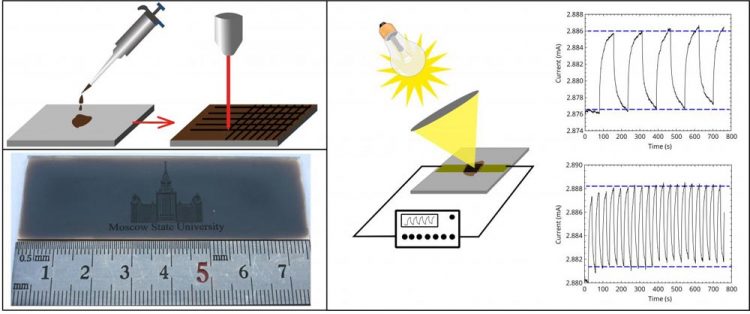Prototype device for measuring graphene-based electromagnetic radiation created

This is a schematic of the structuring of graphene oxide: Photo microstructuring; Prototype circuit of the bolometer and its work. Credit: Stanislav Evlashin
Bolometer is a device for measuring electromagnetic radiation energy flow based on measurement of variations of physical parameters of thermosensitive element as a result of heating by absorption of radiation energy.
“We studied thermal and optical properties of the carbon structures derived from the reduced graphene oxide in a wide range of wavelengths from visible to infrared. In addition to the optical and thermal properties of the carbon structures, we have demonstrated the bolometer prototype that operates at room temperature without additional cooling”, says Stanislav Evlashin, the first author of the article, the researcher of the Skobeltsyn Institute of Nuclear Physics Lomonosov Moscow State University (SINP MSU), PhD in Physico-Mathematical Sciences.
Synthesis and investigations of the new materials for bolometric sensors have a great scientific and practical importance. Such materials should possess a high effective absorption over a wide spectral range, high stable thermoresistive effect (change in electrical conductance with temperature), and, of course, they must be cheap to manufacture.
To create bolometer prototype the water solution of graphene oxide was used, which was obtained by the standard method of graphite oxidation, which is known and widely used. The resulting suspension of graphene oxide was deposited on the substrate for subsequent laser microstructuring. Laser treatment causes partial reduction of graphene oxide film and changes morphology, consequently, it changes optical and thermal properties of graphene oxide.
The material synthesis and development of the bolometer prototype was held at SINP MSU. Studies on the optical properties were carried out at Physics Department of Moscow State University. Research on the thermal properties were carried out at LPI RAS.
“Laser microstructuring of graphene oxide opens up the possibility of selective creation of antireflective, thermally-conductive and electrically-conductive coatings. Developed method is quite cheap, compatible with conventional semiconductor technology and allows you to create antiabsorbing coatings that would cover large areas on almost any surface. The observed properties of reduced graphene oxide partially show the prospects of it's use in bolometric matrices and other IR devices,” – says Stanislav Evlashin.
Media Contact
All latest news from the category: Power and Electrical Engineering
This topic covers issues related to energy generation, conversion, transportation and consumption and how the industry is addressing the challenge of energy efficiency in general.
innovations-report provides in-depth and informative reports and articles on subjects ranging from wind energy, fuel cell technology, solar energy, geothermal energy, petroleum, gas, nuclear engineering, alternative energy and energy efficiency to fusion, hydrogen and superconductor technologies.
Newest articles

A ‘language’ for ML models to predict nanopore properties
A large number of 2D materials like graphene can have nanopores – small holes formed by missing atoms through which foreign substances can pass. The properties of these nanopores dictate many…

Clinically validated, wearable ultrasound patch
… for continuous blood pressure monitoring. A team of researchers at the University of California San Diego has developed a new and improved wearable ultrasound patch for continuous and noninvasive…

A new puzzle piece for string theory research
Dr. Ksenia Fedosova from the Cluster of Excellence Mathematics Münster, along with an international research team, has proven a conjecture in string theory that physicists had proposed regarding certain equations….



